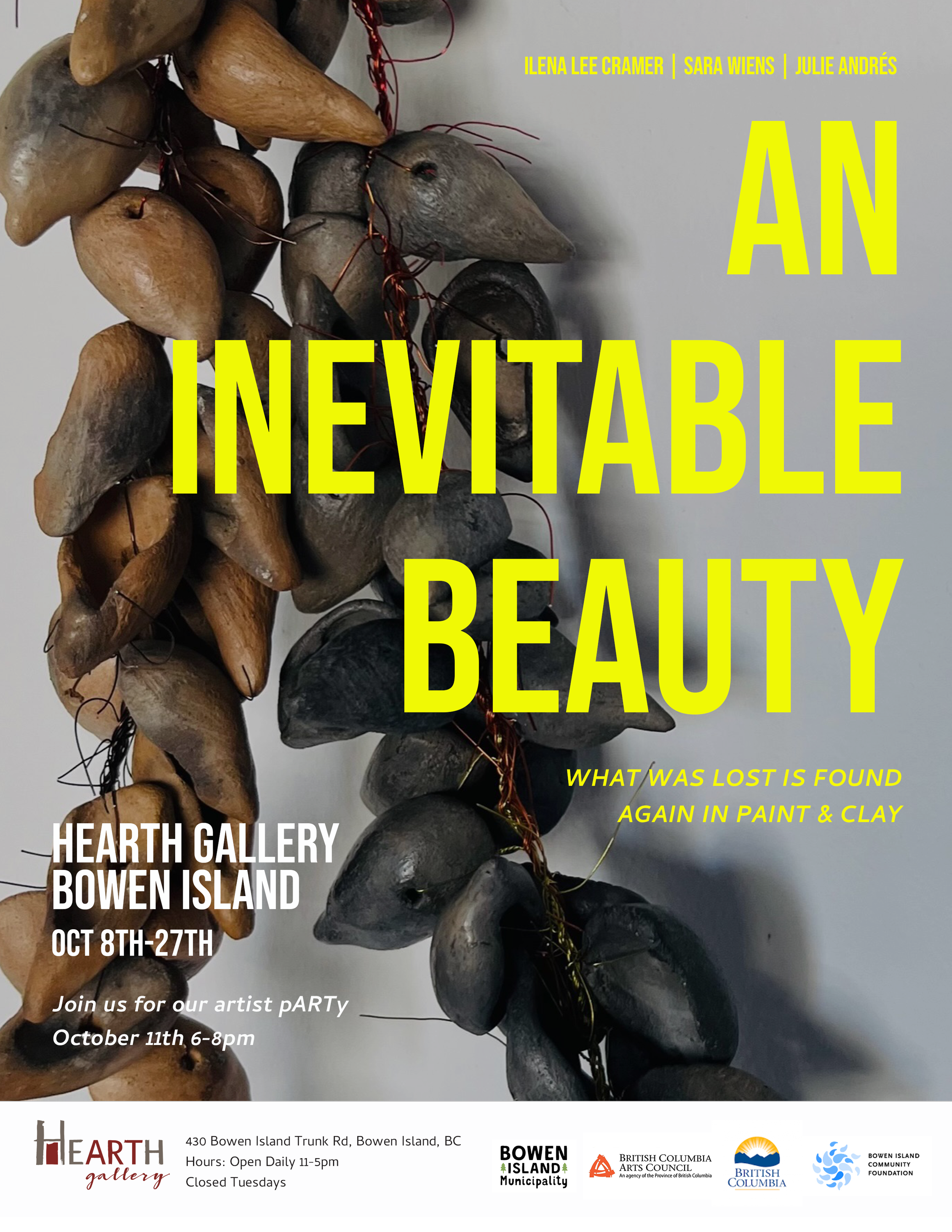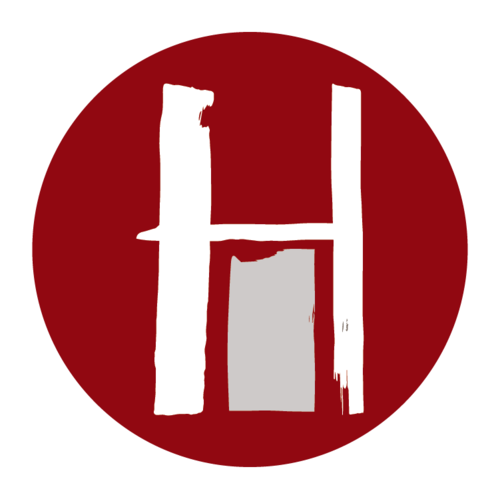


OPENS Oct 8th-27th
What was lost is found again in paint and clay
By artists Sara Wiens, Ilena Lee Cramer and Julie Andrés
We are three women whose lives are wildly different, yet a kernel within each of our hearts strives for the same thing: finding beauty in this troubled world.
Where we find that can be in the feeling that swells when a glistening cache of clay is discovered along a shoreline, in the hope that emerges when a blade of green is seen in the ashen remains of a forest fire, or in the dark mirror of a puddle holding summer’s fallen leaves as they decay.
As artists we are seekers, witnesses to these processes, finding always that the Earth knows what to do. In the mud and soot and clay we see both an end and a beginning in the transformations underway.
Loss and change can be devastating, and the struggle to find what lies beyond the ruins can be great. But we can and do find it, find beauty, inevitably.
An Inevitable Beauty
ABOUT THE WORK
Artist Statement – Julie Andrés
A leaf’s journey doesn’t end when it loses its capacity to photosynthesize. It succumbs to senescence, then floats, drifts, crumbles, and feeds itself to the microbes and fungi of the earth.
Following long pandemic years with trees as my primary physical friends, it feels apropos to focus on this aspect of their lives as I rediscover myself as an artist in late adulthood.
Culturally, freshness and youth are held as the ideal, and the opposite end of life is often hidden and even disparaged. But the grace of a tender green leaf continues through its subsequent stages; after a busy summer of converting sunlight into sugars, it leaves the parent plant behind and flutters earthward. While no longer alive, it can dazzle us along its way with astonishing colour transformation.
The autumn leaves that gather at the edges of water bodies particularly fascinate me. The sky and trees cradle them with their watery reflections, and they eventually sink and become the very mud below. I paint their world between the sky and the mud.
The tree species I have been exploring most are black cottonwood (Populus trichocarpa, native to western North America), Chinese weeping willow (Salix babylonica, native to north eastern Asia), and silver maple (Acer sachcharinium, native to eastern North America). These species are abundant in John Hendry Park (Trout Lake) in East Vancouver where I live.
I like to mingle deep knowledge of my subject with spontaneous fantasy that emerges through imagination. I endeavour to capture a sense of suspended time, yet ephemeral seasonality in this inquiry.
Artist Statement - Sara Wiens
Charcoal Sentinels- Climate Change, Conservation, and a Hopeful Landscape.
Wiens’ current work is about the local loss of indigenous trees and forest due climate change. Fire season is becoming an expected and unwelcomely frequent event. Wiens’ paintings document areas around the North Shuswap that have experienced fire in recent years. Charcoal trees are left standing guard, memorializing the event, yet beneath the trees vibrant undergrowth is claiming back the scorched earth. As companies and individuals persist in destructive environmental action, climate change denial is also flaring up. It’s challenging to have compassion for people who are angry and afraid while we are running out of time. We are holding the tensions of grief and hope while our land is on fire.
Having lived through several stressful fire situations and seasons, Wiens has experienced the anxiety of smoky skies and being on alert to flee. In the last 8 years, the proximity of local fires meant that surrounding rural areas are evacuating their animals and her city of Salmon Arm is housing the outlying residents during periods of intense fire activity. Most recently in 2023, the sky became black with raining ash the night the city opened a large music festival. That fire, the Adams Lake Complex wildfire, resulted in 176 structural losses and even more damaged structures. At the same time, Kelowna was experiencing the aggressive Grouse Complex wildfires that evacuated 30,000 residents and destroyed or damaged 303 structures. Meanwhile, in the North Shuswap, matters were exacerbated when residents of the affected areas decided to abscond with fire fighting equipment in order to protect their personal properties believing that the BC Wildfire service was not doing enough. Deep distrust of government and anti-authority sentiments were factors in the conflict.
The summer before, Wiens and her family drove past the site of a previous fire along the Coquihalla highway. At the time of the fire in 2021, the Wiens family (including a niece from Bowen Island) barely made it through the road before it closed due to the fire danger. It was the closest they had been to an out of control wildfire and it was terrifying. The following year, the scene was breathtaking with fluorescent green undergrowth punctuated by patches of purple fireweed. The haunting beauty of this now peaceful scene compared to the experience of panic the year before was so striking that Wiens set out to draw attention to the dichotomy of these strangely apocalyptic stands of charcoal trees while the earth below them sprouts hope.
This hope could inspire us to do more to face the challenges of our climate. Hope that we will resist the urge to ignore and subsequently lose our chance to address the problem of climate disasters. Hope, because the earth knows what to do if we are paying attention.
Artist Statement- Ilena Lee Cramer
(she or Them)
Ilena creates on the unceded, ancestral, and occupied, traditional lands of the xʷməθkʷəy̓əm, Səl̓ílwətaʔ, and Skwxwú7mesh Nations of the Coast Salish peoples.
I live and create on the stolen, ancestral, occupied, and traditional lands of the xʷməθkʷəy̓əm, Səl̓ílwətaʔ, and Skwxwú7mesh Nations of the Coast Salish peoples (Vancouver, BC, Canada). I am of Saxon heritage from eastern and northern Europe. A multi-disciplinary artist before it was a thing; I am a visual and theatre artist, teacher, bartender, traveler, writer, survivor, witch and lifelong student of ceramics and clay. I studied ballet in Russia during Perestroika, received an arts degree in Alaska in 1996, founded Screaming Weenie Productions - Canadas longest running queer mandated arts organization, made pottery in the mountains of Mexico, and created many many plays around the world. My current practice finds local landscape, environment and materials encountering myth, story and history.
Connecting the spirit and body to this land - my work with locally foraged materials and ancient fireing techniques is about placing my own whole self in this adopted home land - All of the parts of me coming together into a body in relation with both human and non-human beings : a body of work, of play, of self. By creating - and openly sharing my process - I am forging a path to physically re-connect with ideas of reciprocity between land, people and spirit. Old systems are eroding, and we are laying down new patterns, like beds of clay on the shifting shores of history. This work is reconnection of community, science, spiritual practice, and the land. By creating with materials everyone has access to, with techniques that anyone can do - outside of capitalistic, colonial and consumptive art practice - I am laying groundwork for change.
The clay of Nex̱wlélex̱wm built the original Vancouver City hall, and was used for the streets of Gastown. The clay was mined from Deep Bay, and the bricks manufactured in Millers Landing before the resort was built. That wonderful clay is still in abundance, and is easily accessible at low tide.
In generations past weather was top of mind if you were a farmer or fisherman - one's livelihood was likely ‘in the weather’. Urban and technological advances took most of us ‘inside’ and we became less concerned with the weather. But now the weather is often the leading story on the news again.
I have created these works with the clay found on Nex̱wlélex̱wm, with bits and bobs washed up on these beaches. How can we find joy and beauty in the world as it is seemingly becoming a wreck before our eyes? But we all can make a choice to create something beautiful and find hope in the pieces of this broken/beautiful world.
Ilena Lee Cramer (She/Them)
https://www.instagram.com/ilenaleecramer
AN INEVITABLE BEAUTY
By Fleur Sinclair
The Hearth Gallery is pleased to announce Julie Andres, Illena Lee Cramer and Sara Wiens’ first collaborative show, An Inevitable Beauty, (October 8th - 27th).
In this thought-provoking show the three artists combine their multidisciplinary talents into an exploration of powerful and all-encompassing themes of grief, transformation and hope. Through their differing styles and perspectives, they realize the beauty that prevails through decay, mud and ash.
Andres uses leaves as narrative vessels capturing their journey from growth to decay. Her work suspends time with leaves caught in a single moment of falling. Through her portrayal of the leaves, delicate movement, vibrant colours and soft blurred lines her pieces show not only decline but also renewal.
Cramer’s works take transformation far more literally as she molds raw materials into sculptures that weave across the room. Using clay foraged on Nex̱wlélex̱wm, Bowen Island, the same clay used in Vancouver's First City Hall, she connects history, community and tradition. Highlighting our connection with the earth even in the most urban areas, while also showcasing her own personal evolution.
Wiens examines natural cycles of wounding, dormancy, and regeneration. Her landscapes reflect the psyche’s resilience, where ash trees bloom through new grass, embodying the slow but inevitable return of beauty through loss.
Together these three artists not only embrace the growth and beauty of nature but also the decay and grief of it, both the Inevitable Beauty and the inevitable end. Learning and experimenting through these never-ending cycles.
Come join us for the artist pARTy on October 11th, 6 - 8pm, for your chance to have a drink, meet the artists and witness An Inevitable Beauty.

